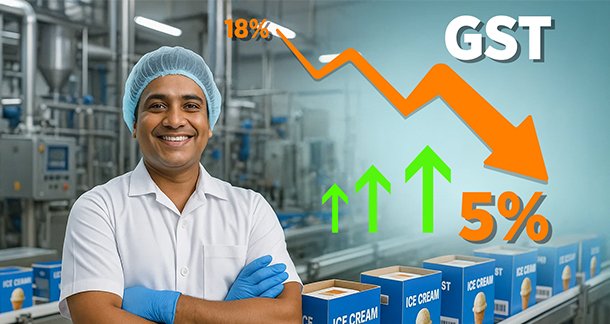The Indian ice cream market has just savored a revolution. The sector is no longer subjected to the “luxury” tax and is now considered part of the ordinary man’s food category, following the GST Council’s decision to cut tax on ice cream from the earlier 18%. For years, high taxes were being shared by manufacturers, distributors, and customers alike. Now, with this tremendous relief, there is a wave of anticipation across the entire value chain — from dairy farmers to shopkeepers and consumers.
This victory comes after many years of sustained efforts by the Indian Ice Cream Manufacturers Association (IICMA). Mr. Sudhir Shah, President of IICMA, along with its members, has been persistently engaging with the government to highlight that ice cream is a product enjoyed to beat the heat, not a luxury item. It is a wholesome dairy product, relished equally by children, families, and senior citizens. Their reasoning, backed by data and ground realities, finally persuaded policymakers.
At this crucial juncture, the industry also extends its heartfelt gratitude to the Hon’ble President of India, Smt. Droupadi Murmu ji; the visionary leadership of the Hon’ble Prime Minister, Shri Narendra Modi ji; the Finance Minister, Smt. Nirmala Sitharaman ji; and many other respected ministers who consistently lent a patient ear to the industry’s concerns and took decisions in the collective interest of all stakeholders.
The Benefits of the GST Cut
For Manufacturers
The earlier 18% GST had created what was known as an “inverted duty structure.” Companies were paying high taxes on inputs such as milk powder, butter, packaging material, and cocoa but were not receiving timely refunds, which strained their working capital. This imbalance has now been removed with the new 5% GST. As a result, manufacturers can operate with better cash flow, fewer refund delays, and greater certainty. This also frees up more funds for upgrading plants and expanding capacity
For Consumers
For customers, the effect is straightforward: lower prices. A strawberry cone priced at ₹35 earlier can now be bought for ₹30, while a family tub that was sold at ₹250 could now be available for around ₹220. This 10–12% decrease will reduce ice cream prices not just in urban areas but also in Tier-II and Tier-III cities. Cheaper prices mean consumption is likely to rise, with a shift towards branded or packaged ice creams rather than loose or unorganized options, ensuring greater safety and hygiene.

For Dairy and the Economy
Growth in ice cream sales translates to greater demand for milk, butter, and milk powder. This is encouraging for farmers and cooperatives, as it supplements rural incomes and adds value to milk. More sales also mean more jobs, more logistics, greater cold chain investment, and overall growth for the food industry.
Guidelines for Implementation
The GST cut is a massive opportunity. However, to ensure success, businesses must manage the transition effectively. Key guidelines include:
Passing on the Benefit: The government expects that the 13% cut will be passed on to consumers. Firms must modify MRPs or offer discounts. Documentation is required to demonstrate compliance with anti-profiteering rules.
MRP Relabelling: Old stock can be relabelled with new MRPs (permitted up to December 2025) or sold with old labels, provided companies issue public advertisements and official communication indicating revised prices. At least two public notices must be made, along with intimation to Legal Metrology authorities.
Input Tax Credit (ITC): ITC can still be claimed on stock purchased under 18% GST before 22nd Sept. Distributors and retailers holding such stock can adjust the credit or claim a refund. Manufacturers must maintain accurate records.
ERP & IT Systems: Billing systems, HSN codes, and tax rates must be updated quickly. Parallel checks are essential to avoid invoicing errors during the transition.
Contracts & Procurement: Open POs and long-term vendor contracts need revision. Suppliers can issue credit notes for products billed at 18% but received later.
Communication and Education: Teams, suppliers, wholesalers, and retailers must be educated on new costs and compliance requirements. Customers should be informed through advertisements, posters, and circulars about the revised lower MRPs.
Overcoming the Challenges
Naturally, such a large change also brings short-term challenges. The key challenges and solutions are:
Margin Pressure on Retailers: As MRPs come down, retailers may fear reduced margins. Companies can support them with revised trade schemes, discounts, or promotional offers during the transition.
Relabelling Efforts: Relabelling lakhs of packs may not be feasible. Manufacturers can instead advertise the discounts at points of sale and pass on the benefit directly.
Independent Assurance and Audit: Independent checks should verify that the benefit is passed on to end-consumers. Organisations must maintain detailed records of revised MRPs and communication efforts to prove compliance.
System Readiness: ERP and IT systems must be upgraded immediately. During the first few weeks, invoices should be tested and cross-checked to prevent errors.
State Credits: Some state-level credits may be reduced following the tax cut. Industry groups need to continue engaging with state governments to protect such schemes.

Why This Change is Revolutionary
This reduction in GST is more than a financial adjustment, it is an acknowledgment that ice cream belongs in the Indian food basket alongside essentials like atta and dal. It demonstrates that when clear logic and evidence are presented, policymakers listen and act.
This framework guarantees fairness for producers, affordability for consumers, income expansion for farmers, and market growth for allied industries. Most importantly, it paves the way for innovation. Companies can now invest more in developing new products such as no-sugar or low-sugar ice creams, fat-free ranges, high-protein options, and premium lines. New technologies, including extrusion lines capable of mass-producing ₹5 and ₹10 products with “no-hand-touch” hygiene, are also emerging.
This reform sets off a virtuous cycle: cheaper prices → higher demand → more production → stronger dairy demand → greater investment → job creation → healthier economic growth.
Conclusion
The reduction in GST on ice cream reflects both recognition and opportunity. It acknowledges that ice cream is no longer just a treat but a mainstream, healthful product. It provides the industry with the chance to grow responsibly, innovate continuously, and bring joy to millions of families, affordably.
The way forward requires diligence and communication, but the destination is clear: a better, safer, more innovative yet still affordable ice cream for India.
About Author
By Ajay Kumar Dubey
General Manager Sri Srinivasa Dairy Products Pvt Ltd
Hyderabad (Scoops Ice Cream)
ajay@scoopsindia.com



